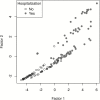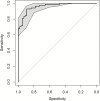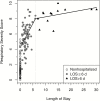Development of a Global Respiratory Severity Score for Respiratory Syncytial Virus Infection in Infants
- PMID: 28011907
- PMCID: PMC5388274
- DOI: 10.1093/infdis/jiw624
Development of a Global Respiratory Severity Score for Respiratory Syncytial Virus Infection in Infants
Erratum in
-
Erratum.J Infect Dis. 2017 Sep 15;216(6):786. doi: 10.1093/infdis/jix303. J Infect Dis. 2017. PMID: 28934442 Free PMC article. No abstract available.
Abstract
Background: Respiratory syncytial virus (RSV) infection in infants has recognizable clinical signs and symptoms. However, quantification of disease severity is difficult, and published scores remain problematic. Thus, as part of a RSV pathogenesis study, we developed a global respiratory severity score (GRSS) as a research tool for evaluating infants with primary RSV infection.
Methods: Previously healthy infants <10 months of age with RSV infections representing the spectrum of disease severity were prospectively evaluated. Clinical signs and symptoms were collected at 3 time points from hospitalized infants and those seen in ambulatory settings. Data were also extracted from office, emergency department, and hospital records. An unbiased data-driven approach using factor analysis was used to develop a GRSS.
Results: A total of 139 infants (84 hospitalized and 55 nonhospitalized) were enrolled. Using hospitalization status as the output variable, 9 clinical variables were identified and weighted to produce a composite GRSS. The GRSS had an area under the receiver operator curve of 0.961. Construct validity was demonstrated via a significant correlation with length of stay (r = 0.586, P < .0001).
Conclusions: Using routine clinical variables, we developed a severity score for infants with RSV infection that should be useful as an end point for investigation of disease pathogenesis and as an outcome measure for therapeutic interventions.
Keywords: Lower respiratory tract infection; respiratory severity score; respiratory syncytial virus; upper respiratory tract infection.
© The Author 2016. Published by Oxford University Press for the Infectious Diseases Society of America. All rights reserved. For permissions, e-mail: journals.permissions@oup.com.
Figures




Similar articles
-
Hospitalization for respiratory syncytial virus bronchiolitis and disease severity in twins.Isr Med Assoc J. 2013 Nov;15(11):701-4. Isr Med Assoc J. 2013. PMID: 24511652
-
Impact of severe disease caused by respiratory syncytial virus in children living in developed countries.Pediatr Infect Dis J. 2003 Feb;22(2 Suppl):S13-8; discussion S18-20. doi: 10.1097/01.inf.0000053881.47279.d9. Pediatr Infect Dis J. 2003. PMID: 12671448
-
Prevalence of respiratory syncytial virus infection in Italian infants hospitalized for acute lower respiratory tract infections, and association between respiratory syncytial virus infection risk factors and disease severity.Pediatr Pulmonol. 2002 Jun;33(6):458-65. doi: 10.1002/ppul.10047. Pediatr Pulmonol. 2002. PMID: 12001280
-
Testing models predicting severity of respiratory syncytial virus infection on the PICNIC RSV database. Pediatric Investigators Collaborative Network on Infections in Canada.Arch Pediatr Adolesc Med. 1995 Nov;149(11):1217-20. doi: 10.1001/archpedi.1995.02170240035005. Arch Pediatr Adolesc Med. 1995. PMID: 7581752 Review.
-
Biomarkers for Disease Severity in Children Infected With Respiratory Syncytial Virus: A Systematic Literature Review.J Infect Dis. 2020 Oct 7;222(Suppl 7):S648-S657. doi: 10.1093/infdis/jiaa208. J Infect Dis. 2020. PMID: 32794555
Cited by
-
Burden of illness in infants and young children hospitalized for respiratory syncytial virus: A rapid review.Can Commun Dis Rep. 2021 Sep 10;47(9):381-396. doi: 10.14745/ccdr.v47i09a05. eCollection 2021 Sep 10. Can Commun Dis Rep. 2021. PMID: 34650335 Free PMC article.
-
Respiratory Viral Infections in Patients With Cancer or Undergoing Hematopoietic Cell Transplant.Front Microbiol. 2018 Dec 12;9:3097. doi: 10.3389/fmicb.2018.03097. eCollection 2018. Front Microbiol. 2018. PMID: 30619176 Free PMC article. Review.
-
Measuring respiratory syncytial virus infection severity in hospitalized children using the Pediatric Respiratory Syncytial Virus Electronic Severity and Outcome Rating System (PRESORS).Influenza Other Respir Viruses. 2022 Nov;16(6):1091-1100. doi: 10.1111/irv.13028. Epub 2022 Aug 14. Influenza Other Respir Viruses. 2022. PMID: 35965419 Free PMC article.
-
Unbiased analysis of peripheral blood mononuclear cells reveals CD4 T cell response to RSV matrix protein.Vaccine X. 2020 Apr 21;5:100065. doi: 10.1016/j.jvacx.2020.100065. eCollection 2020 Aug 7. Vaccine X. 2020. PMID: 32529184 Free PMC article.
-
Beyond the first breath: comprehensive respiratory syncytial virus prevention through maternal immunization and infant immunoprophylaxis.Asian Biomed (Res Rev News). 2025 Jul 28;19(3):116-130. doi: 10.2478/abm-2025-0015. eCollection 2025 Jun. Asian Biomed (Res Rev News). 2025. PMID: 40735667 Free PMC article. Review.
References
-
- Hall CB. The burgeoning burden of respiratory syncytial virus among children. Infect Disord Drug Targets 2012; 12:92–7. - PubMed
-
- Shay DK, Holman RC, Newman RD, Liu LL, Stout JW, Anderson LJ. Bronchiolitis-associated hospitalizations among US children, 1980–1996. JAMA 1999; 282:1440–6. - PubMed
-
- Stein RT, Martinez FD. Respiratory syncytial virus and asthma: still no final answer. Thorax 2010; 65:1033–4. - PubMed
-
- Stein RT, Sherrill D, Morgan WJ, et al. Respiratory syncytial virus in early life and risk of wheeze and allergy by age 13 years. Lancet 1999; 354:541–5. - PubMed
-
- Bekhof J, Reimink R, Brand PL. Systematic review: insufficient validation of clinical scores for the assessment of acute dyspnoea in wheezing children. Paediatr Respir Rev 2014; 15:98–112. - PubMed
MeSH terms
Grants and funding
LinkOut - more resources
Full Text Sources
Other Literature Sources
Medical
Molecular Biology Databases

